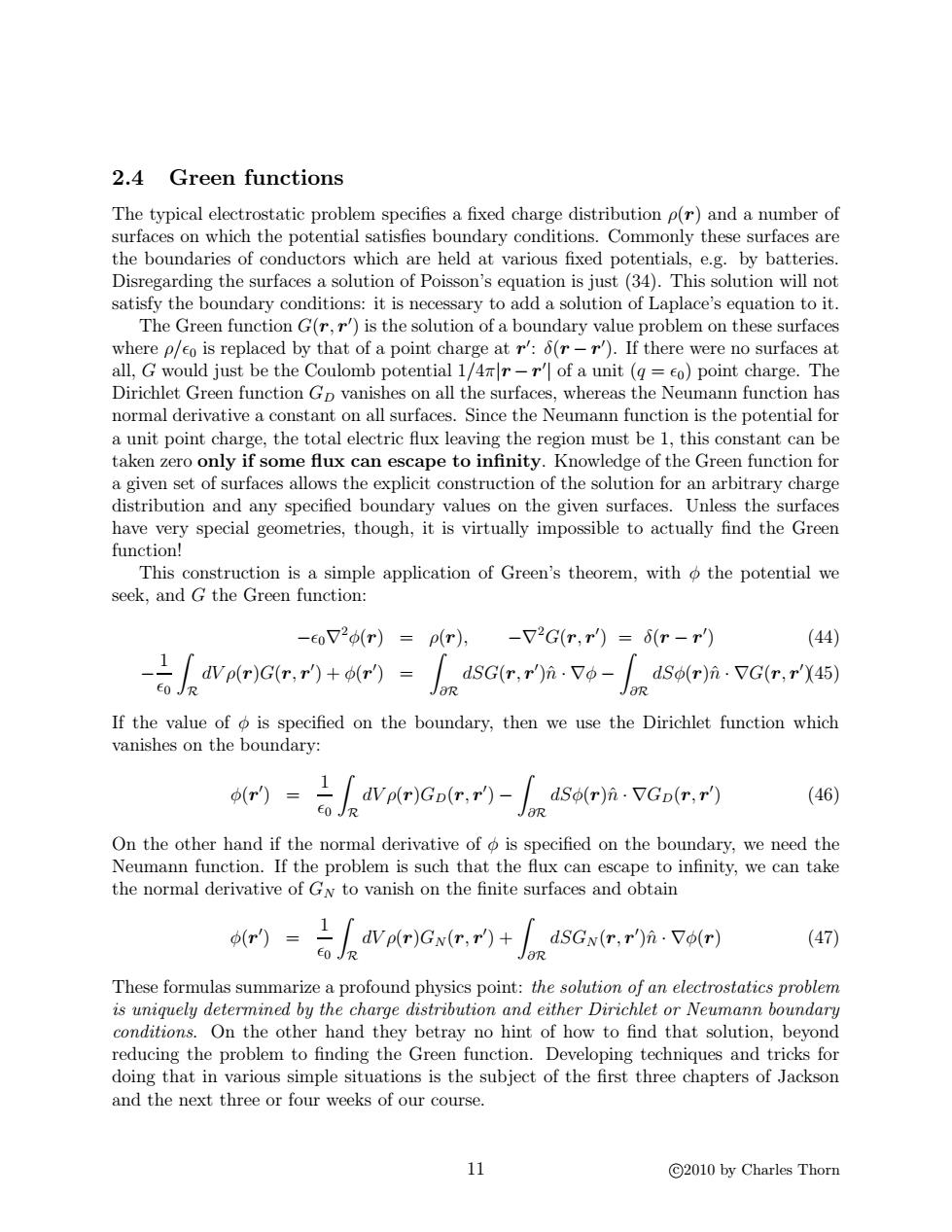正在加载图片...

2.4 Green functions The typical electrostatic problem specifies a fixed charge distribution p(r)and a number of surfaces on which the potential satisfies boundary conditions.Commonly these surfaces are the boundaries of conductors which are held at various fixed potentials,e.g.by batteries Disregarding the surfaces a solution of Poisson's equation is just (34).This solution will not satisfy the boundary conditions:it is necessary to add a solution of Laplace's equation to it. The Green function G(r,r)is the solution of a boundary value problem on these surfaces where p/eo is replaced by that of a point charge at r':(r-r').If there were no surfaces at all,G would just be the Coulomb potential 1/4r-r'l of a unit (g=eo)point charge.The Dirichlet Green function Gp vanishes on all the surfaces,whereas the Neumann function has normal derivative a constant on all surfaces.Since the Neumann function is the potential for a unit point charge,the total electric flux leaving the region must be 1,this constant can be taken zero only if some flux can escape to infinity.Knowledge of the Green function for a given set of surfaces allows the explicit construction of the solution for an arbitrary charge distribution and any specified boundary values on the given surfaces.Unless the surfaces have very special geometries,though,it is virtually impossible to actually find the Green function! This construction is a simple application of Green's theorem,with o the potential we seek,and G the Green function: -oV2(r)=p(r), -72G(r,r)=6(r-r) (44) 1 dvp(r)G(r,r')+(r')=dSG(r,r)i.Vo- dso(r)i.VG(r,r'X45) EO R If the value of o is specified on the boundary,then we use the Dirichlet function which vanishes on the boundary: dvp(r)GD(r,r')-dSo(r)i.VGD(r,r') (46) EO R JaR On the other hand if the normal derivative of o is specified on the boundary,we need the Neumann function.If the problem is such that the flux can escape to infinity,we can take the normal derivative of Gy to vanish on the finite surfaces and obtain d(r)fdvp(r)Gx(r,)+f dsGx(r.r)n.Vo(r) (47) E0 R JOR These formulas summarize a profound physics point:the solution of an electrostatics problem is uniquely determined by the charge distribution and either Dirichlet or Neumann boundary conditions.On the other hand they betray no hint of how to find that solution,beyond reducing the problem to finding the Green function.Developing techniques and tricks for doing that in various simple situations is the subject of the first three chapters of Jackson and the next three or four weeks of our course. 11 ©2010 by Charles Thorn2.4 Green functions The typical electrostatic problem specifies a fixed charge distribution ρ(r) and a number of surfaces on which the potential satisfies boundary conditions. Commonly these surfaces are the boundaries of conductors which are held at various fixed potentials, e.g. by batteries. Disregarding the surfaces a solution of Poisson’s equation is just (34). This solution will not satisfy the boundary conditions: it is necessary to add a solution of Laplace’s equation to it. The Green function G(r, r 0 ) is the solution of a boundary value problem on these surfaces where ρ/0 is replaced by that of a point charge at r 0 : δ(r − r 0 ). If there were no surfaces at all, G would just be the Coulomb potential 1/4π|r − r 0 | of a unit (q = 0) point charge. The Dirichlet Green function GD vanishes on all the surfaces, whereas the Neumann function has normal derivative a constant on all surfaces. Since the Neumann function is the potential for a unit point charge, the total electric flux leaving the region must be 1, this constant can be taken zero only if some flux can escape to infinity. Knowledge of the Green function for a given set of surfaces allows the explicit construction of the solution for an arbitrary charge distribution and any specified boundary values on the given surfaces. Unless the surfaces have very special geometries, though, it is virtually impossible to actually find the Green function! This construction is a simple application of Green’s theorem, with φ the potential we seek, and G the Green function: −0∇2φ(r) = ρ(r), −∇2G(r, r 0 ) = δ(r − r 0 ) (44) − 1 0 Z R dV ρ(r)G(r, r 0 ) + φ(r 0 ) = Z ∂R dSG(r, r 0 )nˆ · ∇φ − Z ∂R dSφ(r)nˆ · ∇G(r, r 0 )(45) If the value of φ is specified on the boundary, then we use the Dirichlet function which vanishes on the boundary: φ(r 0 ) = 1 0 Z R dV ρ(r)GD(r, r 0 ) − Z ∂R dSφ(r)nˆ · ∇GD(r, r 0 ) (46) On the other hand if the normal derivative of φ is specified on the boundary, we need the Neumann function. If the problem is such that the flux can escape to infinity, we can take the normal derivative of GN to vanish on the finite surfaces and obtain φ(r 0 ) = 1 0 Z R dV ρ(r)GN (r, r 0 ) + Z ∂R dSGN (r, r 0 )nˆ · ∇φ(r) (47) These formulas summarize a profound physics point: the solution of an electrostatics problem is uniquely determined by the charge distribution and either Dirichlet or Neumann boundary conditions. On the other hand they betray no hint of how to find that solution, beyond reducing the problem to finding the Green function. Developing techniques and tricks for doing that in various simple situations is the subject of the first three chapters of Jackson and the next three or four weeks of our course. 11 c 2010 by Charles Thorn